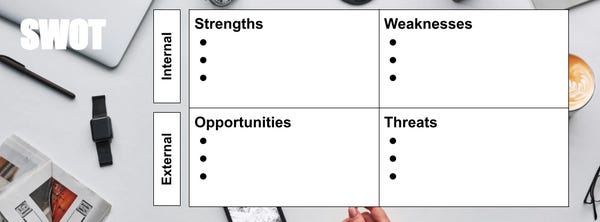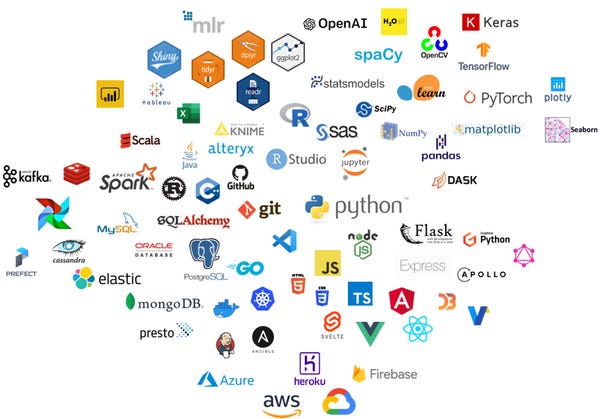Issue #4 - Building Strategic Options, Taking Ownership and more data science stuff
Hey all, thanks for opening up this week’s newsletter.
And a huge thank you to those people who have reached out - it really helps me feel that this newsletter is of value to people.
This week includes:
An admin announcement
Developing Strategic Options (part 1)
Taking ownership of things instead of blaming others
Some more data science tools
Admin announcement
I just wanted to let everyone know that I will be changing from Revue over the next few weeks. Revue is the platform which I use to send these emails out, and is owned and operated by Twitter. However, Twitter has just announced that it will be closing down the Revue platform.
But no worries, I’ll find another one and let you all know before I move over.
MBA - Developing Strategic Options - SWOT (part 1)
The SWOT tool, it’s been around for a long time, I’ve seen it used more times than I can remember - and every time - it wasn’t used to its actual potential.
This week, I’ll go over a quick intro and some pro-tips, but next week I’ll show you how to actually do something useful with it. How to use it to develop your strategic options.
To introduce it, SWOT stands for Strengths, Weaknesses, Opportunities and Threats. In its simplest form, it is a list of items under each category typically structured as shown in the image above.
It’s important to remember - Strengths and Weaknesses are things relating to you - they are ‘internal’. Opportunities and Threats are things outside of you, ‘external’.
An example of a strength for my newsletter could be “I have an MBA and also a PhD” - not many people have that. A weakness could be “I’ve never written a newsletter before”. An opportunity could be seen in some external sources saying things such as “Newsletters are growing their popularity all around us” and “open rates are at an all-time high”. A threat, which turned out to be true could be “the platform you are using could stop offering the service”. So here, the trick is to identify a handful of bullet points for each category.
Now for the pro-tips:
It doesn’t need to be just for a business - you can do them for a range of situations. I’ve done them to help map the next stages of my career. I gave the example of applying it to my newsletter. But it can be applied to anything.
It should be done in comparison to something else. Being able to cut hair isn’t a unique strength compared to other hairdressers, having a shop on a high street in a high-traffic area to fix phones isn’t a strength if there are 10 other phone-fixing shops down the same street. What are your unique strengths and weaknesses compared to others?
Homework - have a go at making a SWOT for something meaningful to you, it could be a business idea, you personally thinking about your career in relation to your colleagues, or for something else you know about.
Next week I’ll show you how to turn the SWOT into your strategic options - I find the next step so useful.
Personal Growth - Ownership
I’m currently reading the book “The Subtle Art of Not Giving a F*ck” by Mark Manson and there is a part in the book which reminds me of a story in another book, but I can’t remember the title of that other book.
Anyways the story goes like this…
There was an author who was writing a book, but he could never finish it. There was always something not quite right, a character maybe needed a little more back story, or maybe one of the chapters didn’t flow as a good as it could. Whatever it was, there was always something. But this went on for way too long and stopped the author from ever sending the book to the publisher. It turns out the reason was that the author was frightened, frightened of two things. Firstly the author was frightened of rejection, imagine having spent so long writing a book for it to be rejected and result in failure. Secondly, the author was afraid of losing their identity. As long as that book wasn’t finished, as long as the book wasn’t rejected by the publisher, as long as he wasn’t told his work was rubbish - the author could continue to be called an author.
The Subtle Art of Not Giving a F*ck - has something similar. Here the book talks about how people hide behind imagined blockers or pin blame on others or their environment. “If only X was different then I’d be happy”, “if only I had more opportunities like Bob, then I would be successful”.
I’ve known people not progress in their careers while others around them have, with the excuse of “I never get those opportunities” when in reality they had the same opportunity but never applied. I’ve known someone lose custody of their children because “I had a traumatic event happen to me a long time ago” when in reality they turned up drunk to the custody hearing at court (in addition to turning up smelling of booze to previous child visits).
Now I’m not saying any of this doesn’t contribute to some outcomes, but what the book (The Subtle Art of Not Giving a F*ck) discusses is how sometimes we use external things/blockers/issues to avoid taking responsibility. Could you have applied for that role? Could you not have had several beers before the custody hearing?
So in a nutshell, we should all be taking more ownership of the things we can. For example, I’m not overweight because my wife fills the cupboards with biscuits and cakes, I’ve overweight because I eat them all and don’t exercise.
What could be improved in your life? And what can you do about it?
My day-to-day Data Science Tool (Part 2)
Last week I shared a bunch of info on my core tools, this week I’m going to talk about one main package and the multiple tools and techniques under that.
So jumping straight in, we’re talking about Scikit Learn (aka sklearn).
It has everything you need to get started with Machine Learning work, and here is a bunch of stuff I use and some I don’t…
PCA - I use this for reducing the number of dimensions (variables/features) to a smaller amount, mainly so I can visualise them. Another technique I use less frequently is Locally Linear Embedding (LLE), I wrote a paper which used this to visualise a dataset of photos (paper).
Clustering - I’ll commonly use Kmeans, it’s just simple. The main limitation is that you need to specify how many clusters you want. You probably don’t know, but you can use the elbow technique to try to figure this out, or sometimes a quicker way is to just jump in and use the DBSCAN method. DBSCAN will find how many clusters there are based on some parameters such as the distance between points. Another nice thing about DBSCAN is that it doesn’t force samples into a specific cluster i.e. they get labelled as -1 meaning that point doesn’t belong to a cluster.
You can see a visual representation of the different clustering algorithms here.
Decision Trees - these are great for building explainable predictive models. The reason - the decision-making process can be visualised, an example shown here. Sometimes I’ll also extend the work to include a Random Forest - which in its basic form can be described as multiple decision trees. An example of a random forest can be seen in a Kaggle tutorial.
Neural Networks - I don’t use sklearn’s neural network, I find it basic and limited, well at least when I looked last. I went through a period of using Keras but more recently started using PyTorch. Maybe it’s from my MSc days but I like playing with the topology and experimenting a little more.
Logistic Regression - Again I don’t use sklearn’s implementation. Instead, I use the statsmodel version. Mainly because I like how the summary information is displayed from the model. An example can be seen here applied to the Titanic dataset.
There you go, I hope that was useful.
As always, hope you all have a great weekend, wishing you all the best.






